The composition and weathering of the continents over geologic time
Affiliations | Corresponding Author | Cite as | Funding information- Share this article





Article views:946Cumulative count of HTML views and PDF downloads.
- Download Citation
- Rights & Permissions
top
Abstract
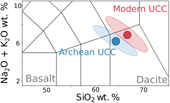
Figures and Tables
 Table 1 Average sediment protolith composition (wt. %) through time. Uncertainties (in the form of a covariance matrix) are given in Table S-3. | 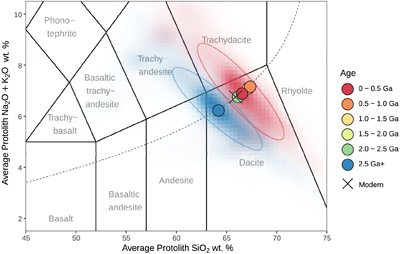 Figure 1 A dacitic composition for Archean UCC. Total Alkali-Silica plot displaying the protoliths of the average sediment for different time periods (Le Maitre et al., 2005). Ellipses indicate standard error (see Supplementary Information). ‘×’ is the pristine igneous precursor of the modern upper continental crust (Rudnick and Gao, 2003). Dashed line is trend described by | 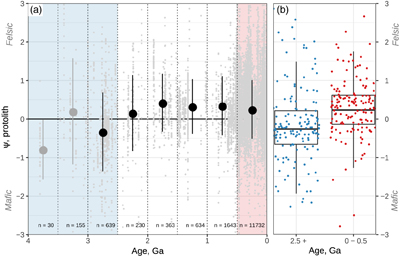 Figure 2 Archean protoliths were more mafic than the present day but equally diverse. (a) Grey points are protolith coefficients, ψ, for individual samples. Mean ψ ± σ for each 0.5 Ga time period given by black circles. Means for >3 Ga greyed out to emphasise low sample coverage. (b) Box and whisker comparison of protolith distributions for samples of age >2.5 and 0–0.5 Ga. Whiskers extend 1.5 × interquartile-range from the upper/lower quartiles. 200 randomly selected samples shown for each age group. | 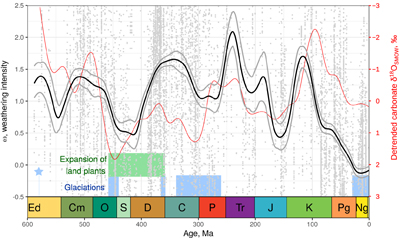 Figure 3 Weathering intensity of sedimentary rocks across the Phanerozoic. Grey points are individual samples, black line is smoothed trend calculated using 30 Myr bandwidth Gaussian kernel, and grey lines show bootstrap uncertainty (see Supplementary Information). Red line is de-trended Oxygen isotope composition of carbonates smoothed using 30 Myr bandwidth Gaussian. See Supplementary Information for origin of Phanerozoic palaeoclimate data. |
| Table 1 | Figure 1 | Figure 2 | Figure 3 |
top
Introduction
The rocks at Earth’s surface are compositionally divided between dense, silica-poor oceanic crust and a buoyant, silica-rich continental crust. It is generally accepted that this dichotomy is maintained by plate tectonics. The emergence of Earth’s first felsic continents therefore could be an indicator for when plate tectonics began. The timing of the earliest felsic continents however remains debated. The Archean (i.e. 2.5–4.0 Ga) continents are often viewed as having a mafic composition similar to the oceanic crust (e.g., Taylor and McLennan, 1986
Taylor, S.R., McLennan, S.M. (1986) The chemical composition of the Archaean crust. Geological Society, London, Special Publications 24, 173–178.
; Tang et al., 2016Tang, M., Chen, K., Rudnick, R.L. (2016) Archean upper crust transition from mafic to felsic marks the onset of plate tectonics. Science 351, 372–375.
) suggesting a late onset for plate tectonics during the Neoarchean, ∼2.5 Ga. However, a contrasting view has emerged of evolved, silica-rich Archean continents (Greber et al., 2017Greber, N.D., Dauphas, N., Bekker, A., Ptáček, M.P., Bindeman, I.N., Hofmann, A. (2017) Titanium isotopic evidence for felsic crust and plate tectonics 3.5 billion years ago. Science 357, 1271–1274.
; Keller and Harrison, 2020Keller, C.B., Harrison, T.M. (2020) Constraining crustal silica on ancient Earth. Proceedings of the National Academy of Sciences 117, 21101–21107.
; Ptáček et al., 2020Ptáček, M.P., Dauphas, N., Greber, N.D. (2020) Chemical evolution of the continental crust from a data-driven inversion of terrigenous sediment compositions. Earth and Planetary Science Letters 539, 116090.
). This view suggests an earlier onset for plate tectonics before 3.5 Ga.Not only is the history of the crust necessary for understanding geodynamics, reactions between the crust and hydrosphere stabilise the planet’s climate (Broecker and Langmuir, 1985
Broecker, W.S., Langmuir, C.H. (2012) Making it comfortable. In: How to build a habitable planet. Princeton University Press, Princeton, NJ, 298–386.
). Continental chemical weathering (the alteration of silicate minerals by reaction with water at Earth’s surface) transfers atmospheric CO2 into carbonate minerals deposited on the ocean floor. This reaction is the major long term sink for CO2 outgassed by the mantle (Walker et al., 1981Walker, J.C.G., Hays, P.B., Kasting, J.F. (1981) A negative feedback mechanism for the long-term stabilization of Earth’s surface temperature. Journal of Geophysical Research: Oceans 86, 9776–9782.
; Berner et al., 1983Berner, R.A., Lasaga, A.C., Garrels, R.M. (1983) The carbonate-silicate geochemical cycle and its effect on atmospheric carbon dioxide over the past 100 million years. American Journal of Science 283, 641–683.
).The geochemical composition of sedimentary rocks is our primary record of crustal evolution on Gyr timescales. However, this archive is challenging to interpret. Chemical weathering strips sediments of mobile elements altering their composition relative to the rocks from which they derive (protoliths). Signals of changing crustal composition are thus obscured by alteration. Additionally, most sediments record the signals of the local catchment they come from, not the continental crust as a whole. Here, we provide new perspectives into the long term composition and alteration of the upper continental crust (UCC). We use novel data analytic methods and the geochemical database produced by the Sedimentary Geochemistry and Paleoenvironments Project.
top
Methods and Data
Most studies aiming to track changes in crustal composition avoid the alteration of sedimentary compositions by selecting weathering-insensitive elemental ratios. Whilst this approach can resolve protolith changes, by design, it cannot provide information on weathering intensity changes. Here, we simultaneously extract signals of both the weathering intensity of sediments and protolith composition.
To do this we use a new method which explains the major element (Si, Al, Fe, Mg, Na, Ca, K) composition of sediments in terms of the composition of their protolith, and how intensely they have been weathered (Lipp et al., 2020
Lipp, A.G., Shorttle, O., Syvret, F., Roberts, G.G. (2020) Major Element Composition of Sediments in Terms of Weathering and Provenance: Implications for Crustal Recycling. Geochemistry, Geophysics, Geosystems 21, e2019GC008758.
). This approach constructs a model for a centred log-ratio transformed composition (after Aitchison, 1986Aitchison, J. (1986) The statistical analysis of compositional data. Chapman and Hall, London, UK.
) x′, as the sum of a weathering vector, , and a protolith vector,
, and a protolith vector,  , relative to the composition of modern UCC:
, relative to the composition of modern UCC:Eq. 1

The coefficients of these vectors correspond to the weathering intensity experienced by a sediment, ω, and its protolith composition, ψ. Deviations from this model cause the misfit, E, to rise. Sediments with protoliths more(/less) felsic than modern UCC have positive(/negative) ψ values. Weathering of rocks causes ω to rise. Here, we modify this method to correct for the effect of sodium-calcium cation exchange that can occur between dissolved species and those adsorbed to clays (e.g., Sayles and Mangelsdorf, 1979
Sayles, F.L., Mangelsdorf, P.C. (1979) Cation-exchange characteristics of Amazon River suspended sediment and its reaction with seawater. Geochimica et Cosmochimica Acta 43, 767–779.
). We also use a recalibrated vector. These modifications reduce the possibility of biases. Some limitations, including diagenesis and marine authigenic clay formation, are discussed in the Supplementary Information but do not significantly affect our results.
vector. These modifications reduce the possibility of biases. Some limitations, including diagenesis and marine authigenic clay formation, are discussed in the Supplementary Information but do not significantly affect our results.We apply this method to the compilation of sedimentary geochemical data produced by the Sedimentary Geochemistry and Paleoenvironments (SGP) research consortium (sgp.stanford.edu). The SGP database compiles geochemical data and geological context information from three sources: 1) direct data entry by SGP team members (mainly Neoproterozoic and Palaeozoic shales with global geographic coverage), 2) the USGS National Geochemical Database (consisting of data from USGS projects from the 1960-1990s; mainly Phanerozoic samples of all lithologies from the United States), and 3) the USGS Critical Metals in Black Shales database (a global shale database spanning all of Earth history). In total we analyse 17,472 major element compositions each associated with an age. Full details of data, pre-processing and analysis is found in the Supplementary Information.
top
The Archean Protolith
First, we investigate changes in the average composition of the exposed UCC through time. To overcome local heterogeneities we calculate composite samples using the arithmetic mean of all samples in 500 Myr time intervals (Table S-1). Because of low sampling density in the Archean, we average all samples older than 2.5 Ga to create an Archean composite. We solve Equation 1 for each composite to calculate ω and ψ, the weathering and protolith coefficients.
Table 1 Average sediment protolith composition (wt. %) through time. Uncertainties (in the form of a covariance matrix) are given in Table S-3.
| Age, Ga | SiO2 | Al2O3 | Fe2O3T | MgO | Na2O | CaO | K2O |
| 0–0.5 | 66.5 | 14.6 | 5.32 | 2.32 | 3.98 | 4.32 | 2.95 |
| 0.5–1.0 | 67.3 | 14.5 | 4.99 | 2.05 | 4.04 | 3.98 | 3.17 |
| 1.0–1.5 | 67.1 | 14.5 | 5.06 | 2.11 | 4.03 | 4.05 | 3.11 |
| 1.5–2.0 | 67.3 | 14.5 | 5.00 | 2.06 | 4.04 | 3.99 | 3.16 |
| 2.0–2.5 | 66.1 | 14.7 | 5.48 | 2.46 | 3.95 | 4.48 | 2.85 |
| 2.5+ | 64.1 | 14.9 | 6.22 | 3.16 | 3.82 | 5.27 | 2.46 |
We can use Equation 1 to reconstruct the full major element composition of a sediment’s protolith from just its ψ value. By substituting the ω value of a sediment in Equation 1 for that of pristine igneous rocks (ω0 = −0.271; see Supplementary Information) the composition of a sediment’s protolith is returned. The calculated compositions of the average sediment protoliths through time are shown in Table 1. These protoliths can be analysed as igneous rocks, with e.g., a Total Alkali-Silica plot (Fig. 1). The average Archean protolith was silica-rich and dacitic in composition but slightly more mafic than younger protoliths. This evolved composition for Archean protoliths is similar, albeit marginally more felsic, to the estimate of Ptáček et al. (2020)
Ptáček, M.P., Dauphas, N., Greber, N.D. (2020) Chemical evolution of the continental crust from a data-driven inversion of terrigenous sediment compositions. Earth and Planetary Science Letters 539, 116090.
but arrived at using independent methodologies. The average protolith has remained constant since 2.5 Ga.
Figure 1 A dacitic composition for Archean UCC. Total Alkali-Silica plot displaying the protoliths of the average sediment for different time periods (Le Maitre et al., 2005
Le Maitre, R.W., Streckeisen, A., Zanettin, B., Le Bas, M.J., Bonin, B., Bateman, P. (2005) Igneous Rocks: A Classification and Glossary of Terms. Cambridge University Press, Cambridge.
). Ellipses indicate standard error (see Supplementary Information). ‘×’ is the pristine igneous precursor of the modern upper continental crust (Rudnick and Gao, 2003Rudnick, R.L., Gao, S. (2003) Composition of the Continental Crust. Treatise on Geochemistry 3, 659.
). Dashed line is trend described by .
.As sediments derive from broad regions, their protoliths, in aggregate, can be assumed to be representative of the average exposed crustal composition. Our estimate for the average protolith of recent, <0.5 Ga, sedimentary rocks (Fig. 1) is within error of the estimate of UCC as averaged by surface sampling (Rudnick and Gao, 2003
Rudnick, R.L., Gao, S. (2003) Composition of the Continental Crust. Treatise on Geochemistry 3, 659.
), validating this approach. A uniformitarian interpretation of the dacitic Archean UCC is that plate tectonics commenced no later than the early Archean.Nonetheless, we note the limitations about inferring global conditions from the small inventory of Archean samples which are highly susceptible to preservation and sampling biases (Korenaga, 2013
Korenaga, J. (2013) Initiation and Evolution of Plate Tectonics on Earth: Theories and Observations. Annual Review of Earth and Planetary Sciences 41, 117–151.
). This low sample density in the Archean gives low statistical significance to variability of age-interval means within the Archean (Fig. 2a). Evolved igneous rocks could also be generated in the absence of plate tectonics (Reimink et al., 2014Reimink, J.R., Chacko, T., Stern, R.A., Heaman. L.M. (2014) Earth’s earliest evolved crust generated in an Iceland-like setting. Nature Geoscience 7, 529–533.
).
Figure 2 Archean protoliths were more mafic than the present day but equally diverse. (a) Grey points are protolith coefficients, ψ, for individual samples. Mean ψ ± σ for each 0.5 Ga time period given by black circles. Means for >3 Ga greyed out to emphasise low sample coverage. (b) Box and whisker comparison of protolith distributions for samples of age >2.5 and 0–0.5 Ga. Whiskers extend 1.5 × interquartile-range from the upper/lower quartiles. 200 randomly selected samples shown for each age group.
Focusing exclusively on the average sediment protolith neglects other features in our dataset. The protolith coefficients, ψ, for individual samples through time (Fig. 2a) show a large diversity in protoliths throughout Earth’s history, including the Archean. If each individual ψ represents a catchment averaged protolith, then the diversity of rocks at the Earth’s surface has remained nearly constant since ∼4 Ga. The ψ distributions from before 2.5 Ga are compared to those from 0–0.5 Ga in Figure 2b. Whilst the median of the two distributions is different, there is still considerable overlap. The high diversity of exposed rocks, and their on-average evolved nature, suggests that during the Archean the exposed continental crust was more similar to the modern crust than it was different. Near-constant protolith diversity from the Archean to Recent is independently evidenced by the ratio of felsic to mafic igneous rocks in a comprehensive compilation of geologic columns in North America (Fig. S-5; Peters et al., 2018
Peters, S.E., Husson, J.M., Czaplewski, J. (2018) Macrostrat: A Platform for Geological Data Integration and Deep-Time Earth Crust Research. Geochemistry, Geophysics, Geosystems 19, 1393–1409.
). This near-constant protolith diversity supports uniformitarian models of petrogenetic processes, e.g., long lived plate tectonics.top
Crustal Weathering on Billion Year Timescales
Second, we explore how the efficiency of CO2 drawdown by crustal weathering may have evolved through time. The weathering of mafic rocks sequesters more CO2 than felsic rocks due to their higher concentrations of Ca and Mg (e.g., Dessert et al., 2003
Dessert, C., Dupré, B., Gaillardet, J., François, L.M., Allègre, C.J. (2003) Basalt weathering laws and the impact of basalt weathering on the global carbon cycle. Chemical Geology. 202, 257–273.
). The more mafic Archean UCC could result in more CO2 sequestered per mass of rock weathered than modern UCC. This effect could potentially bring the weathering CO2 sink in balance with mantle outgassing despite a smaller exposed continental area (Albarede et al., 2020Albarede, F., Thibon, F., Blichert-Toft, J., Tsikos, H. (2020) Chemical archeoceanography. Chemical Geology 548, 119625.
). To quantify this effect, we calculate the chemical depletion fraction for any ω–ψ pair, assuming that Al2O3 is immobile (see Supplementary Information). The mass of each element mobilised due to weathering per kg of protolith eroded can then be converted into moles of carbonate-bound CO2 assuming the stoichiometry
and efficient Mg-Ca exchange at mid-ocean ridges (Holland, 1984
Holland, H.D. (1984) The Chemical Evolution of the Atmosphere and Oceans. Princeton University Press, Princeton, NJ.
). Any ω–ψ pair can thus be converted into a (maximum) amount of CO2 deposited per kg of weathered protolith (Fig. S-3a).Weathering the Archean protolith sequesters ∼25 % more CO2 than subsequent protoliths for the same weathering intensity (Fig. S-3b). Since the Archean, the CO2 sequestered per kg UCC eroded has not changed considerably (Fig. S-3a). On timescales greater than 0.5 Gyr therefore, any change in Earth’s total weathering flux must have been achieved by changing the absolute amount of erosion, not the weathering intensity. Hence, to maintain an equitable climate over these timescales, secular changes in volcanic CO2 outgassing must have been compensated for by changes in amounts of physical erosion. Alternatively, changes to other aspects of the carbon cycle could have taken place (e.g., changing the reverse weathering flux; Isson and Planavsky, 2018
Isson, T.T., Planavsky, N.J. (2018) Reverse weathering as a long-term stabilizer of marine pH and planetary climate. Nature 560, 471–475.
).top
Crustal Weathering over the Phanerozoic
Finally, we explore how global weathering intensity has changed during the Phanerozoic. On 10–100 Myr timescales, weathering intensity is believed to respond to global climate state as part of a negative feedback (Walker et al., 1981
Walker, J.C.G., Hays, P.B., Kasting, J.F. (1981) A negative feedback mechanism for the long-term stabilization of Earth’s surface temperature. Journal of Geophysical Research: Oceans 86, 9776–9782.
; Berner et al., 1983Berner, R.A., Lasaga, A.C., Garrels, R.M. (1983) The carbonate-silicate geochemical cycle and its effect on atmospheric carbon dioxide over the past 100 million years. American Journal of Science 283, 641–683.
). Individual sediments only record the weathering intensity of their source regions, but collectively they may reflect these global shifts in silicate weathering intensity.Figure 3 shows the weathering coefficient, ω, for the ∼12,000 samples less than 600 Ma. The lowest weathering intensity occurs in the Neogene. Other periods of low intensity are observed in the late Ordovician/Silurian, late Permian and the Jurassic. Peaks in weathering intensity are found in the Carboniferous, Triassic and Cretaceous. We find that sampling biases do not strongly affect these observations (see Supplementary Information; Fig. S-4).

Figure 3 Weathering intensity of sedimentary rocks across the Phanerozoic. Grey points are individual samples, black line is smoothed trend calculated using 30 Myr bandwidth Gaussian kernel, and grey lines show bootstrap uncertainty (see Supplementary Information). Red line is de-trended Oxygen isotope composition of carbonates smoothed using 30 Myr bandwidth Gaussian. See Supplementary Information for origin of Phanerozoic palaeoclimate data.
The ω fluctuations we observe are on timescales too long (10’s Myr) to be explained by the silicate weathering feedback acting in response to short term climatic perturbations. The weathering intensity trend is instead consistent with long term CO2 mass balance forced by changes in the magnitude of carbon sources and sinks. For example, an increased flux of volcanic CO2 would result initially in an imbalance in the geologic carbon cycle, as the weathering sink is unchanged. However, as atmospheric CO2 rises on Myr timescales, the weathering intensity of rocks should rise due to higher pCO2 driving warmer and wetter conditions. The carbon cycle will then achieve balance albeit at an elevated CO2 level and altered climate state. An increase in carbon sinks driven by, e.g., mountain building, would have the opposite effect. The global intensity of weathering hence changes in concert with the balance of carbon sources and sinks (e.g., Raymo and Ruddiman, 1992
Raymo, M.E., Ruddiman, W.F. (1992) Tectonic forcing of late Cenozoic climate. Nature 359, 117–122.
; Berner and Caldeira, 1997Berner, R.A., Caldeira, K. (1997) The need for mass balance and feedback in the geochemical carbon cycle. Geology 25, 955–956.
; McKenzie et al., 2016McKenzie, N.R., Horton, B.K., Loomis, S.E., Stockli, D.F., Planavsky, N.J., Lee, C.-T.A. (2016) Continental arc volcanism as the principal driver of icehouse-greenhouse variability. Science 352, 444–447.
).This hypothesis predicts a positive correlation between the average surface temperature and weathering intensity. We can test these predictions by comparing the smoothed weathering trend to climate proxies. First we consider the de-trended oxygen isotope composition of marine carbonates, considered a proxy for global climate (Veizer et al., 2000
Veizer, J., Godderis, Y., Francois, L.M. (2000) Evidence for decoupling of atmospheric CO2 and global climate during the Phanerozoic eon. Nature 408, 698–701.
). When the δ18O of marine carbonates is heavy (associated with cooler climates) we observe a lower weathering intensity while the opposite is true for lighter δ18O (associated with warmer climates).The validity of the δ18O record however is controversial as it is susceptible to diagenetic overprinting (e.g., Ryb and Eiler, 2018
Ryb, U., Eiler, J.M. (2018) Oxygen isotope composition of the Phanerozoic ocean and a possible solution to the dolomite problem. Proceedings of the National Academy of Sciences 115, 6602–6607.
). As a result we also compare our ω record to a less ambiguous record of climate state: evidence of glaciated poles. We observe local minima in chemical weathering intensity during ice house climates (Ordovician-Silurian, Permian, Neogene). We note however that the end Devonian glaciation coincides with a period of observed high weathering intensity. These observations generally match the relationship between weathering intensities and climate state that is predicted by carbon mass balance.The lack of a state change in weathering intensity following the Palaeozoic emergence of land plants further illustrates the importance of carbon mass balance. The expansion of land plants, by increased pedogenesis, initially caused an increase in the weathering carbon sink. The resulting carbon cycle imbalance is then resolved by a decrease in weathering intensity by the mechanism described above (e.g., Algeo et al., 1995
Algeo, T.J., Berner, R.A., Maynard, J.B., Scheckler, S.E. (1995) Late Devonian Oceanic Anoxic Events and Biotic Crises: “Rooted” in the Evolution of Vascular Land Plants? GSA TODAY, 24.
). Hence, only a transient ω response is observed in response to the stepwise expansion of land-plants.top
Summary
A large inventory of sedimentary rock major element compositions has been deconvolved into a record of crustal composition and weathering intensity. Results indicate an evolved and heterogeneous Archean crust, which suggests an early onset of plate tectonics. Weathering of this Archean crust was ∼25 % more efficient at sequestering atmospheric CO2 than modern day UCC. On long, Gyr, timescales the weathering intensity of the crust has remained constant. By contrast, on short, 100 Myr, timescales weathering intensity responds to global climate shifts consistent with a silicate weathering feedback responding to changes in carbon sources or sinks.
top
Acknowledgements
AGL is funded by the Natural Environment Research Council Grantham Institute SSCP DTP (grant number NE/L002515/1). OS acknowledges support from NERC grants NE/T012455/1 and NE/T00696X/1. This work was supported by CASP. British Geological Survey authors (JFE, PRW) published with permission of the Executive Director of the British Geological Survey, UKRI. We thank Gareth Roberts for helpful comments. The authors are grateful to Julie Dumoulin, Clinton Scott, Akshay Mehra, Justin Strauss, Jon Husson, Tristan White, Tiffani Fraser (Yukon Geological Survey), Ben Gill, Florian Kurzweil, Danielle Thomson, Wing Chan, Joseph Magnall and Lawrence Och for their contributions to the Sedimentary Geochemistry and Paleoenvironments Project. Scripts and data are available at github.com/AlexLipp/crustal-comp and archived at the point of submission at doi.org/10.5281/zenodo.4309952.
Editor: Sophie Opfergelt
top
Author Contributions
AGL and OS conceived of the study. AGL performed data analysis and prepared the manuscript. EAS led development of the Sedimentary Geochemistry and Paleoenvironments Project. JJB, DC, PWC, LDM, KD, SQD, JFE, UCF, AJ, BWJ, PK, CBK, MK, AJM, NTM, BOC, SEP, NJP, SRR, SDS, PRW and JY all contributed to the Sedimentary Geochemistry and Paleoenvironments Project. JFE helped guide discussion of the role of diagenesis. NJP helped guide discussion of Phanerozoic carbon cycle. SEP produced Figure S-5. All authors contributed to manuscript revision.
top
References
Aitchison, J. (1986) The statistical analysis of compositional data. Chapman and Hall, London, UK.
 Show in context
Show in context This approach constructs a model for a centred log-ratio transformed composition (after Aitchison, 1986) x′, as the sum of a weathering vector,  , and a protolith vector,
, and a protolith vector,  , relative to the composition of modern UCC:
, relative to the composition of modern UCC:
View in article
Albarede, F., Thibon, F., Blichert-Toft, J., Tsikos, H. (2020) Chemical archeoceanography. Chemical Geology 548, 119625.
 Show in context
Show in context This effect could potentially bring the weathering CO2 sink in balance with mantle outgassing despite a smaller exposed continental area (Albarede et al., 2020).
View in article
Algeo, T.J., Berner, R.A., Maynard, J.B., Scheckler, S.E. (1995) Late Devonian Oceanic Anoxic Events and Biotic Crises: “Rooted” in the Evolution of Vascular Land Plants? GSA TODAY, 24.
 Show in context
Show in context The resulting carbon cycle imbalance is then resolved by a decrease in weathering intensity by the mechanism described above (e.g., Algeo et al., 1995).
View in article
Berner, R.A., Caldeira, K. (1997) The need for mass balance and feedback in the geochemical carbon cycle. Geology 25, 955–956.
 Show in context
Show in context The global intensity of weathering hence changes in concert with the balance of carbon sources and sinks (e.g., Raymo and Ruddiman, 1992; Berner and Caldeira, 1997; McKenzie et al., 2016).
View in article
Berner, R.A., Lasaga, A.C., Garrels, R.M. (1983) The carbonate-silicate geochemical cycle and its effect on atmospheric carbon dioxide over the past 100 million years. American Journal of Science 283, 641–683.
 Show in context
Show in context This reaction is the major long term sink for CO2 outgassed by the mantle (Walker et al., 1981; Berner et al., 1983).
View in article
On 10–100 Myr timescales, weathering intensity is believed to respond to global climate state as part of a negative feedback (Walker et al., 1981; Berner et al., 1983).
View in article
Broecker, W.S., Langmuir, C.H. (2012) Making it comfortable. In: How to build a habitable planet. Princeton University Press, Princeton, NJ, 298–386.
 Show in context
Show in context Not only is the history of the crust necessary for understanding geodynamics, reactions between the crust and hydrosphere stabilise the planet’s climate (Broecker and Langmuir, 1985).
View in article
Dessert, C., Dupré, B., Gaillardet, J., François, L.M., Allègre, C.J. (2003) Basalt weathering laws and the impact of basalt weathering on the global carbon cycle. Chemical Geology. 202, 257–273.
 Show in context
Show in context The weathering of mafic rocks sequesters more CO2 than felsic rocks due to their higher concentrations of Ca and Mg (e.g., Dessert et al., 2003).
View in article
Greber, N.D., Dauphas, N., Bekker, A., Ptáček, M.P., Bindeman, I.N., Hofmann, A. (2017) Titanium isotopic evidence for felsic crust and plate tectonics 3.5 billion years ago. Science 357, 1271–1274.
 Show in context
Show in context However, a contrasting view has emerged of evolved, silica-rich Archean continents (Greber et al., 2017; Keller and Harrison, 2020; Ptáček et al., 2020).
View in article
Holland, H.D. (1984) The Chemical Evolution of the Atmosphere and Oceans. Princeton University Press, Princeton, NJ.
 Show in context
Show in context The mass of each element mobilised due to weathering per kg of protolith eroded can then be converted into moles of carbonate-bound CO2 assuming the stoichiometry  and efficient Mg-Ca exchange at mid-ocean ridges (Holland, 1984).
and efficient Mg-Ca exchange at mid-ocean ridges (Holland, 1984).
View in article
Isson, T.T., Planavsky, N.J. (2018) Reverse weathering as a long-term stabilizer of marine pH and planetary climate. Nature 560, 471–475.
 Show in context
Show in context Alternatively, changes to other aspects of the carbon cycle could have taken place (e.g., changing the reverse weathering flux; Isson and Planavsky, 2018).
View in article
Keller, C.B., Harrison, T.M. (2020) Constraining crustal silica on ancient Earth. Proceedings of the National Academy of Sciences 117, 21101–21107.
 Show in context
Show in context However, a contrasting view has emerged of evolved, silica-rich Archean continents (Greber et al., 2017; Keller and Harrison, 2020; Ptáček et al., 2020).
View in article
Korenaga, J. (2013) Initiation and Evolution of Plate Tectonics on Earth: Theories and Observations. Annual Review of Earth and Planetary Sciences 41, 117–151.
 Show in context
Show in context Nonetheless, we note the limitations about inferring global conditions from the small inventory of Archean samples which are highly susceptible to preservation and sampling biases (Korenaga, 2013).
View in article
Le Maitre, R.W., Streckeisen, A., Zanettin, B., Le Bas, M.J., Bonin, B., Bateman, P. (2005) Igneous Rocks: A Classification and Glossary of Terms. Cambridge University Press, Cambridge.
 Show in context
Show in context A dacitic composition for Archean UCC. Total Alkali-Silica plot displaying the protoliths of the average sediment for different time periods (Le Maitre et al., 2005).
View in article
Lipp, A.G., Shorttle, O., Syvret, F., Roberts, G.G. (2020) Major Element Composition of Sediments in Terms of Weathering and Provenance: Implications for Crustal Recycling. Geochemistry, Geophysics, Geosystems 21, e2019GC008758.
 Show in context
Show in context To do this we use a new method which explains the major element (Si, Al, Fe, Mg, Na, Ca, K) composition of sediments in terms of the composition of their protolith, and how intensely they have been weathered (Lipp et al., 2020).
View in article
McKenzie, N.R., Horton, B.K., Loomis, S.E., Stockli, D.F., Planavsky, N.J., Lee, C.-T.A. (2016) Continental arc volcanism as the principal driver of icehouse-greenhouse variability. Science 352, 444–447.
 Show in context
Show in context The global intensity of weathering hence changes in concert with the balance of carbon sources and sinks (e.g., Raymo and Ruddiman, 1992; Berner and Caldeira, 1997; McKenzie et al., 2016).
View in article
Peters, S.E., Husson, J.M., Czaplewski, J. (2018) Macrostrat: A Platform for Geological Data Integration and Deep-Time Earth Crust Research. Geochemistry, Geophysics, Geosystems 19, 1393–1409.
 Show in context
Show in context Near-constant protolith diversity from the Archean to Recent is independently evidenced by the ratio of felsic to mafic igneous rocks in a comprehensive compilation of geologic columns in North America (Fig. S-5; Peters et al., 2018).
View in article
Ptáček, M.P., Dauphas, N., Greber, N.D. (2020) Chemical evolution of the continental crust from a data-driven inversion of terrigenous sediment compositions. Earth and Planetary Science Letters 539, 116090.
 Show in context
Show in context However, a contrasting view has emerged of evolved, silica-rich Archean continents (Greber et al., 2017; Keller and Harrison, 2020; Ptáček et al., 2020).
View in article
This evolved composition for Archean protoliths is similar, albeit marginally more felsic, to the estimate of Ptáček et al. (2020) but arrived at using independent methodologies.
View in article
Raymo, M.E., Ruddiman, W.F. (1992) Tectonic forcing of late Cenozoic climate. Nature 359, 117–122.
 Show in context
Show in context The global intensity of weathering hence changes in concert with the balance of carbon sources and sinks (e.g., Raymo and Ruddiman, 1992; Berner and Caldeira, 1997; McKenzie et al., 2016).
View in article
Reimink, J.R., Chacko, T., Stern, R.A., Heaman. L.M. (2014) Earth’s earliest evolved crust generated in an Iceland-like setting. Nature Geoscience 7, 529–533.
 Show in context
Show in context Evolved igneous rocks could also be generated in the absence of plate tectonics (Reimink et al., 2014).
View in article
Rudnick, R.L., Gao, S. (2003) Composition of the Continental Crust. Treatise on Geochemistry 3, 659.
 Show in context
Show in context ‘×’ is the pristine igneous precursor of the modern upper continental crust (Rudnick and Gao, 2003). Dashed line is trend described by  .
.
View in article
Our estimate for the average protolith of recent, <0.5 Ga, sedimentary rocks (Fig. 1) is within error of the estimate of UCC as averaged by surface sampling (Rudnick and Gao, 2003), validating this approach.
View in article
Ryb, U., Eiler, J.M. (2018) Oxygen isotope composition of the Phanerozoic ocean and a possible solution to the dolomite problem. Proceedings of the National Academy of Sciences 115, 6602–6607.
 Show in context
Show in context The validity of the δ18O record however is controversial as it is susceptible to diagenetic overprinting (e.g., Ryb and Eiler, 2018).
View in article
Sayles, F.L., Mangelsdorf, P.C. (1979) Cation-exchange characteristics of Amazon River suspended sediment and its reaction with seawater. Geochimica et Cosmochimica Acta 43, 767–779.
 Show in context
Show in context Here, we modify this method to correct for the effect of sodium-calcium cation exchange that can occur between dissolved species and those adsorbed to clays (e.g., Sayles and Mangelsdorf, 1979).
View in article
Tang, M., Chen, K., Rudnick, R.L. (2016) Archean upper crust transition from mafic to felsic marks the onset of plate tectonics. Science 351, 372–375.
 Show in context
Show in context The Archean (i.e. 2.5–4.0 Ga) continents are often viewed as having a mafic composition similar to the oceanic crust (e.g., Taylor and McLennan, 1986; Tang et al., 2016) suggesting a late onset for plate tectonics during the Neoarchean, ∼2.5 Ga.
View in article
Taylor, S.R., McLennan, S.M. (1986) The chemical composition of the Archaean crust. Geological Society, London, Special Publications 24, 173–178.
 Show in context
Show in context The Archean (i.e. 2.5–4.0 Ga) continents are often viewed as having a mafic composition similar to the oceanic crust (e.g., Taylor and McLennan, 1986; Tang et al., 2016) suggesting a late onset for plate tectonics during the Neoarchean, ∼2.5 Ga.
View in article
Veizer, J., Godderis, Y., Francois, L.M. (2000) Evidence for decoupling of atmospheric CO2 and global climate during the Phanerozoic eon. Nature 408, 698–701.
 Show in context
Show in context First we consider the de-trended oxygen isotope composition of marine carbonates, considered a proxy for global climate (Veizer et al., 2000).
View in article
Walker, J.C.G., Hays, P.B., Kasting, J.F. (1981) A negative feedback mechanism for the long-term stabilization of Earth’s surface temperature. Journal of Geophysical Research: Oceans 86, 9776–9782.
 Show in context
Show in context This reaction is the major long term sink for CO2 outgassed by the mantle (Walker et al., 1981; Berner et al., 1983).
View in article
On 10–100 Myr timescales, weathering intensity is believed to respond to global climate state as part of a negative feedback (Walker et al., 1981; Berner et al., 1983).
View in article
top
Supplementary Information
The Supplementary Information includes:
- Supplementary Information on Data and Methods
- Tables S-1 to S-3
- Figures S-1 to S-5
- Supplementary Information References
Download the Supplementary Information (PDF).
Figures
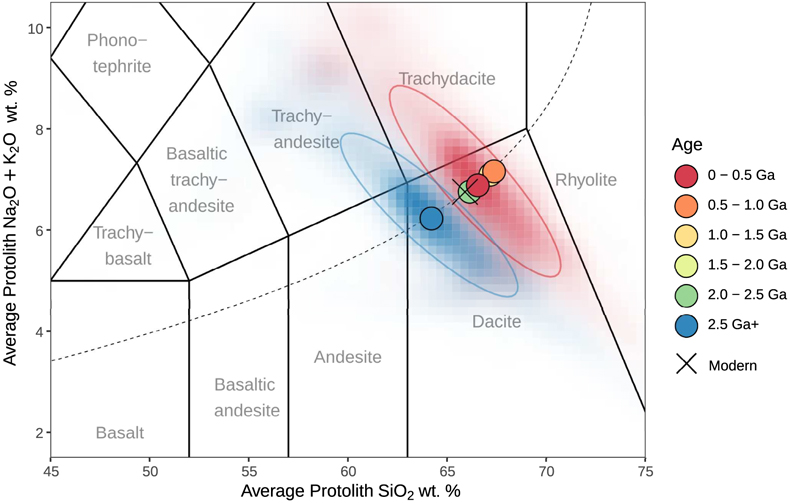
Figure 1 A dacitic composition for Archean UCC. Total Alkali-Silica plot displaying the protoliths of the average sediment for different time periods (Le Maitre et al., 2005
Le Maitre, R.W., Streckeisen, A., Zanettin, B., Le Bas, M.J., Bonin, B., Bateman, P. (2005) Igneous Rocks: A Classification and Glossary of Terms. Cambridge University Press, Cambridge.
). Ellipses indicate standard error (see Supplementary Information). ‘×’ is the pristine igneous precursor of the modern upper continental crust (Rudnick and Gao, 2003Rudnick, R.L., Gao, S. (2003) Composition of the Continental Crust. Treatise on Geochemistry 3, 659.
). Dashed line is trend described by .
.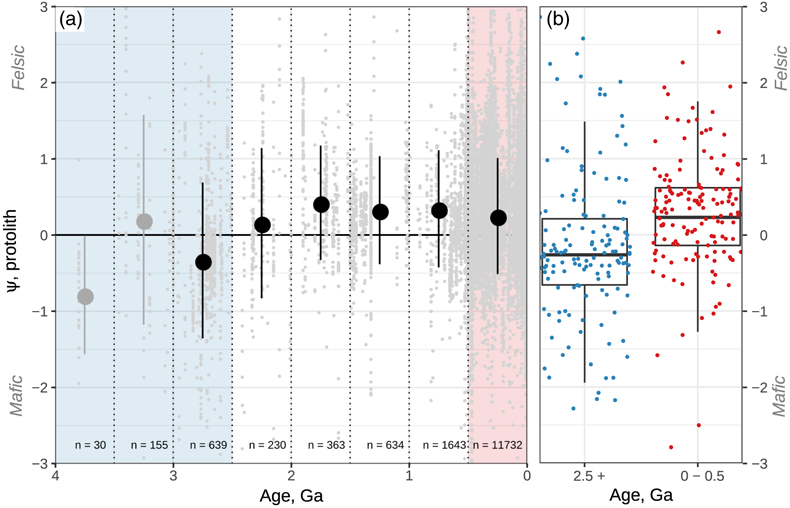
Figure 2 Archean protoliths were more mafic than the present day but equally diverse. (a) Grey points are protolith coefficients, ψ, for individual samples. Mean ψ ± σ for each 0.5 Ga time period given by black circles. Means for >3 Ga greyed out to emphasise low sample coverage. (b) Box and whisker comparison of protolith distributions for samples of age >2.5 and 0–0.5 Ga. Whiskers extend 1.5 × interquartile-range from the upper/lower quartiles. 200 randomly selected samples shown for each age group.
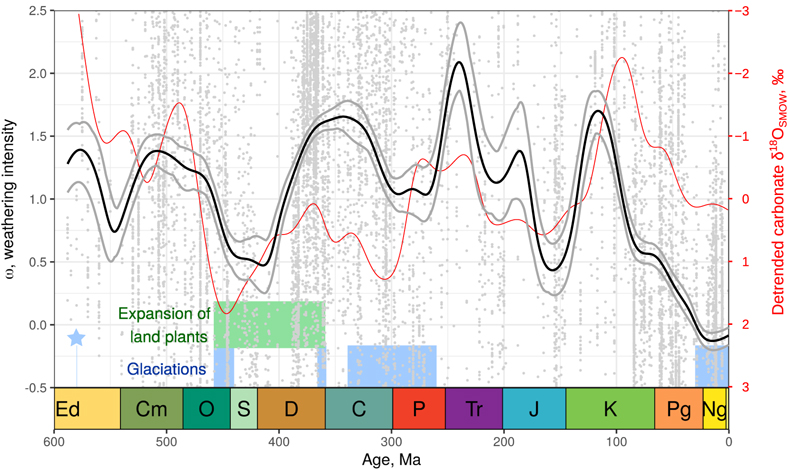
Figure 3 Weathering intensity of sedimentary rocks across the Phanerozoic. Grey points are individual samples, black line is smoothed trend calculated using 30 Myr bandwidth Gaussian kernel, and grey lines show bootstrap uncertainty (see Supplementary Information). Red line is de-trended Oxygen isotope composition of carbonates smoothed using 30 Myr bandwidth Gaussian. See Supplementary Information for origin of Phanerozoic palaeoclimate data.






